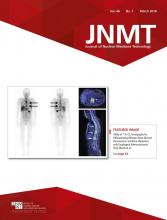Molecular breast imaging is a promising nuclear medicine technique shown to have value in detecting cancer occult on the conventional technologies of mammography and ultrasound. The modality has a high sensitivity and specificity for the detection of malignant breast lesions (1,2) and is useful for supplemental screening in women with dense breast tissue.
Indications
Supplemental screening of women with dense breast tissue (BI-RADS category C or D).
Evaluation of patients who need but cannot undergo MRI (pacemaker, gadolinium allergy, body weight >136 kg [300 lb], severe claustrophobia requiring anesthesia, severe renal disease).
Problem solving for indeterminate imaging findings on other modalities.
Screening of patients with intermediate risk of breast cancer (increased but not >20%), specifically those with a personal history of breast cancer.
Screening of patients with history of silicone injections.
Monitoring of neoadjuvant chemotherapy response.
Evaluation of patients for whom there is persistent clinical concern but negative imaging results.
Unless contraindicated, contrast-enhanced breast MRI should be used in place of molecular breast imaging for…
Staging the extent of disease in patients with a new diagnosis of breast cancer.
Postoperatively evaluating patients with a positive or close surgical margin.
Evaluating implant integrity when there is diagnostic concern about silicone implants.
Contraindications
Pregnancy.
Breast feeding (should be discontinued or expressed milk discarded per institutional guidelines).
Age younger than 40 y, unless clinically indicated.
Lesion of interest near the chest wall or in the axillary tail.
Inability to sit, remain still, or otherwise cooperate for the exam.
Other nuclear medicine studies (e.g., sentinel node imaging) within 24 h.
Patient Preparation
If possible, patients should fast for 3 h before injection of the 99mTc-sestamibi. Patients may take fluids, including black coffee, tea, diet soda, and water. Fasting increases uptake of 99mTc-sestamibi in breast tissue by reducing splanchnic and hepatic blood flow and allows for approximately 20% greater uptake of 99mTc-sestamibi in breast tissue (3).
The patient should remove all clothing above the waist, wear a hospital gown, and, if possible, be given a warm blanket or wrap. Keeping the patient warm increases peripheral blood flow and improves uptake of 99mTc-sestamibi in breast tissue (3).
For patient comfort, all studies should be performed by female technologists.
An indwelling catheter or butterfly flush setup in the contralateral arm should be used to avoid infiltration of the 99mTc-sestamibi.
It is best to image between days 7 and 14 of the menstrual cycle if possible. In some premenopausal women, background uptake of 99mTc-sestamibi in fibroglandular tissue will be less apparent if imaged in the follicular phase than in the luteal phase.
Radiopharmaceutical Identity, Dose, and Route of Administration
Inject 296 MBq (8 mCi) of 99mTc-sestamibi intravenously through a butterfly line or a peripheral line for semiconductor-based systems.
Afterward, flush the syringe with 10 mL of saline to ensure accurate dose administration. 99mTc-sestamibi tends to adhere to plastic syringes (mainly absorbed on the surface of the lubricant used in syringes). Use a syringe with a low adhesion for 99mTc-sestamibi (typically 2.2%–7.7%) (4).
Acquisition Parameters
Static planar imaging: craniocaudal (CC) and mediolateral oblique (MLO) views of each breast.
γ-camera: dual-detector system preferred.
Collimation: low-energy high-sensitivity collimator.
Energy setting: 126–154 keV for NaI- or CsI-based systems and 110–154 keV for cadmium zinc telluride systems.
Acquisition Instructions
Inject 99mTc-sestamibi as described above under “Radiopharmaceutical Identity, Dose, and Route of Administration.”
Record syringe activity before and after injection to calculate the administered dose.
Begin imaging within 5 min after injection.
Seat the patient in the imaging chair and positioned against the camera, with the breast in a CC or MLO view.
Use the p-scope to check that the orientation and distribution of breast tissue in the detector field of view matches the most recent corresponding mammographic image, when available.
Apply light, pain-free compression once the breast is accurately positioned to ensure breast stability and reduce motion artifacts. Before beginning the acquisition, verify that the patient is comfortable enough to complete 10 min of imaging.
For 296-MBq (8 mCi) doses, acquire each image as a static planar image for 10 min.
During acquisition of each image, briefly place the appropriate 57Co laterality marker (R or L) in the field of view until well seen on the persistence screen.
Acquire CC and MLO views of each breast, resulting in a total of 4 acquisitions. On dual-detector systems, this will result in 8 images (upper/lower CC views of each breast and lateral/medial MLO views of each breast).
Before releasing the patient, have the images reviewed by a breast radiologist to determine if additional views are necessary.
Processing Instructions
Load the standard 8 images (4 from the upper detector and 4 from the lower detector) into a display program.
Check the images for issues such as artifacts, hot or cold pixels, and nonbreast activity in the field of view.
Precautions
Patients do not need to follow any special precautions. Although some patients have reported mild allergic reactions to some of the agents in the 99mTc-sestamibi kit (5), there are no contraindications to the administration of 99mTc-sestamibi itself.
Additional Notes
Placement of pillows behind the patient’s back will reduce motion and increase patient comfort, as well as make it easier to position the patient correctly.
Deep lesions close to the chest wall are best seen on the MLO projection.
For patients with very large breasts (which do not fit into the field of view on the CC projection), acquire 2 MLO views of the upper and lower parts of the breast (tiled views) instead of acquiring CC and MLO views.







